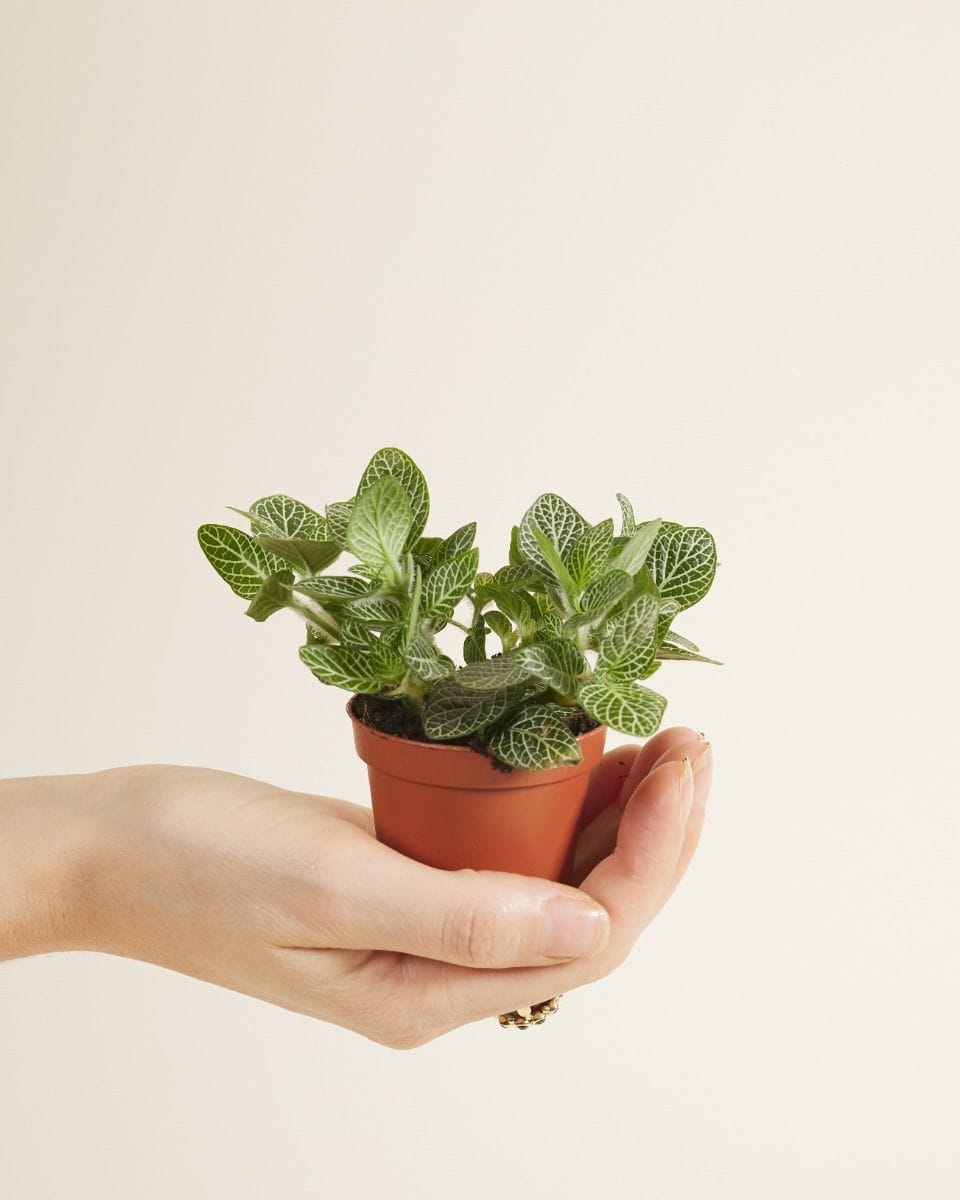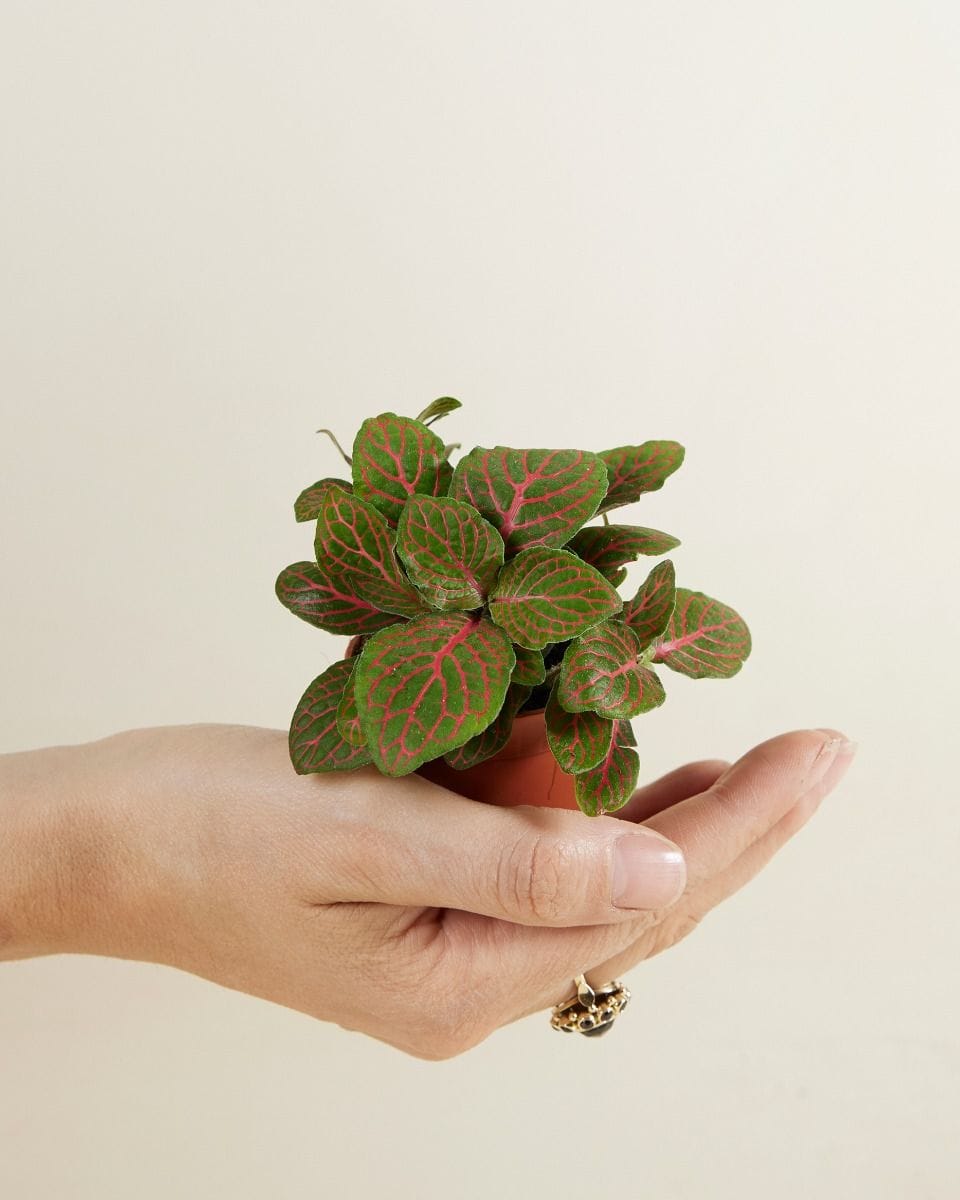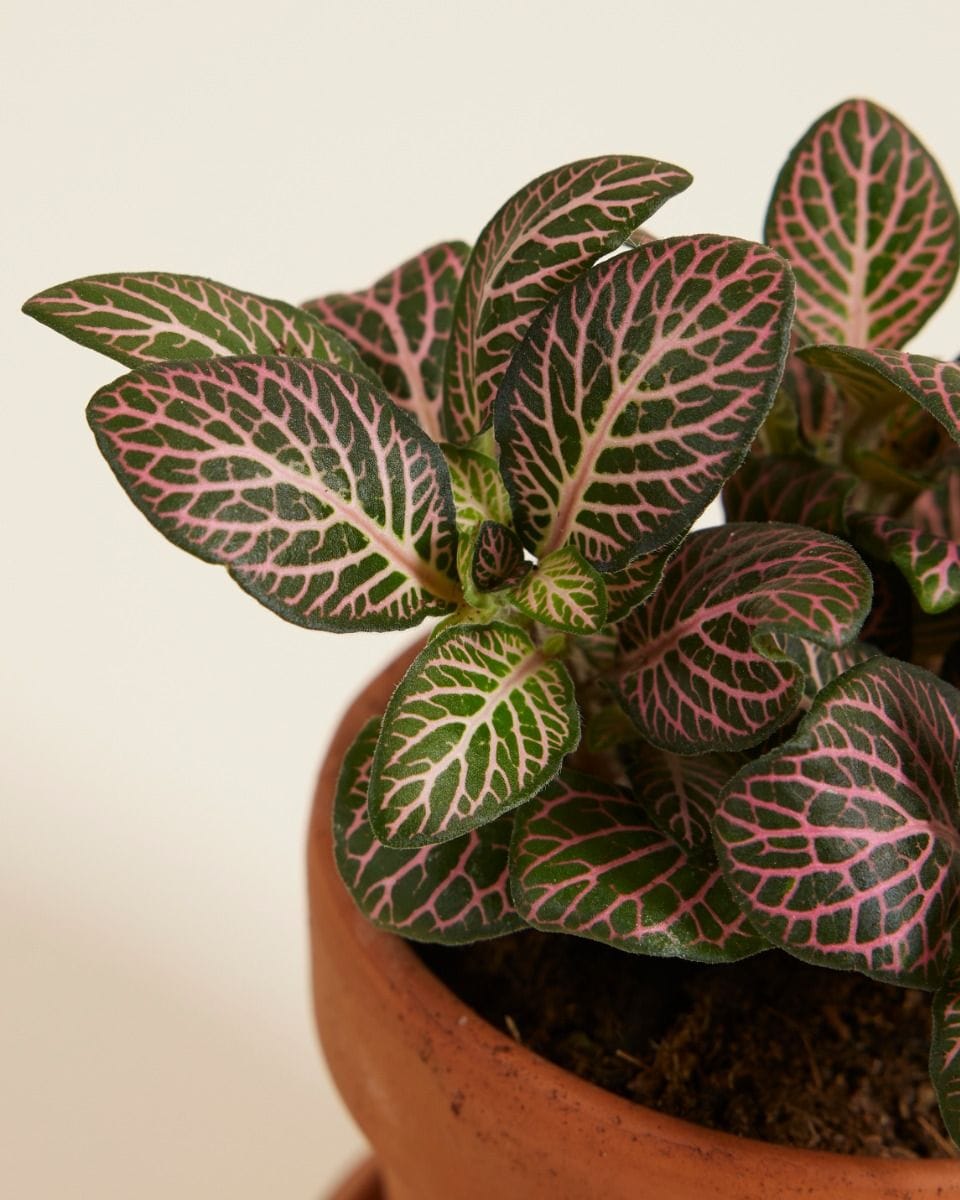In diesem Artikel
- 1 Fittonia (Mosaikpflanze) Pflege: Expertentipps für glückliche Pflanzen
- 1.1 Fittonia Pflege Tips
- 1.1.1 Licht & Standort for Fittonia
- 1.1.2 Gießen
- 1.1.3 Dünger
- 1.1.4 Temperatur
- 1.1.5 Luftfeuchtigkeit
- 1.1.6 Umtopfen
- 1.1.7 Erde & Substrat
- 1.1.8 Fittonias Vermehren
- 1.1.9 Häufige Krankheiten und Schädlinge an Fittonia
- 1.1.10 Fittonia Vielfalt
- 1.1.11 Sind Fittonias giftig?
- 1.2 Fittonia online kaufen bei PLNTS.com
Fittonia (Mosaikpflanze) Pflege: Expertentipps für glückliche Pflanzen
Fittonien sind beliebte Zimmerpflanzen, die für ihre bunten Blätter bekannt sind. Ihre Blätter sind in leuchtenden Farben wie Grün, Rosa, Weiß und Rot erhältlich. Diese Pflanzen sind in Südamerika, insbesondere in Peru, heimisch. Sie wachsen in tropischen Regenwäldern als Bodendecker unter Baumkronen.
Der vollständige botanische Name lautet Fittonia Albivenis und ist nach Elizabeth und Sarah Mary Fitton benannt, zwei irischen Schwestern, die mit dem Buch „Conversations on Botany" jungen Menschen die Wissenschaft der Pflanzen näher brachten. Der spezifische Name Albivensis bedeutet wörtlich „Weiße Adern".
Fun fact! Fittonia-Pflanzen sind auch als Nervenpflanzen bekannt, weil deine komplizierten Aderungen den Nerven im menschlichen Körper ähneln. Man nennt sie auch Mosaikpflanzen, weil deine Blätter Adern haben, die sich irgendwie kreuzen.
Fittonias sind relativ pflegeleicht, stellen aber einige besondere Anforderungen. Wenn du ein:e Pflanzenliebhaber:in bist, die/der sich gerne und oft um seine Pflanzen kümmert, ist dies die richtige Pflanze für dich!
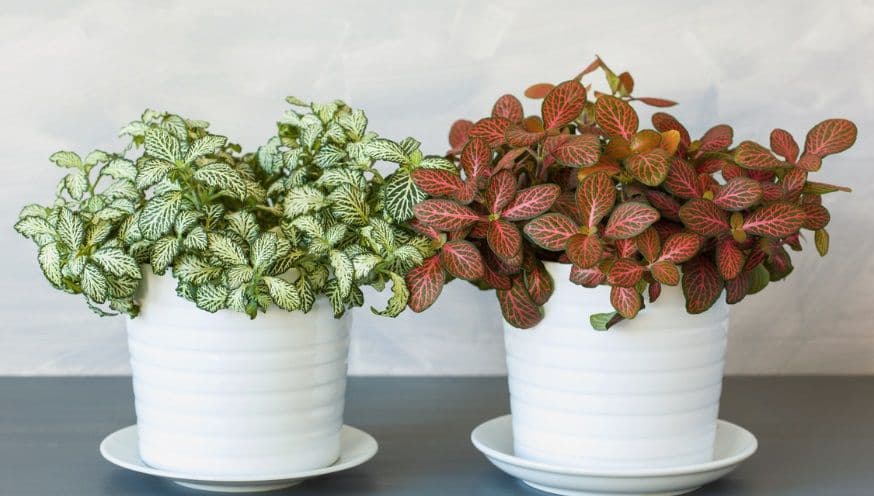
Fittonia (Mosaikpflanze) Pflege: 10 Expertentipps für die erfolgreiche Haltung
- Suche ihr einen Platz mit hellem, indirektem Licht. Fittonien gedeihen in hellem, aber gefiltertem Licht, daher wäre ein Platz in der Nähe eines Fensters ideal.
- Halte sie von direktem Sonnenlicht fern. Das Sonnenlicht kann für die zarten Blätter zu hart sein. Dimme die intensive Sonneneinstrahlung bei Bedarf mit Vorhängen.
- Fittonias müssen oft und gründlich gegossen werden. Sie mögen einen feuchten, aber nicht zu nassen Boden. Warte also, bis sich die obersten 2-3 cm der Erde trocken anfühlen, bevor du erneut gießt.
- Wenn du bemerkst, dass die Blätter deiner Fittonia abfallen, mach dir keine Sorgen! Das ist oft ein Zeichen dafür, dass der Boden zu trocken ist und die Pflanze Durst hat. Sie sollte sich schnell erholen, wenn du ihr etwas zu trinken gibst.
- Fittonias brauchen eine hohe Luftfeuchtigkeit, um zu gedeihen. Halte die Luft feucht, indem du eine Schale mit Wasser in die Nähe der Pflanze stellst, oder verwende einen Raumbefeuchter.
- Halte die Temperatur konstant. Die zarten Blätter dieser Pflanze reagieren empfindlich auf plötzliche Veränderungen. Achte darauf, dass sie nicht in der Nähe von offenen Fenstern und Klimaanlagen stehen.
- Behalte deinen grünen Freund gut im Auge. Wenn du Anzeichen für einen Schädlingsbefall bemerkst, behandle sie umgehend. Fittonia kann Spinnmilben und Wollläuse anziehen, daher solltest du die Blätter regelmäßig kontrollieren.
- Schneide die Stängel der Fittonia zurück, um einen buschigen Wuchs zu fördern. Fittonia lässt sich gut beschneiden und wird buschiger, wenn du die Stängel regelmäßig zurückschneidest.
- Dünge während der Wachstumsperiode alle 2-4 Wochen. Fittonia braucht nicht viel Dünger, aber eine leichte Dosis eines ausgewogenen Düngers alle paar Wochen kann dazu beitragen, dass ihre Blätter gesund bleiben.
- Vergilbende und abfallende Blätter an deiner Fittonia können auf Überwässerung hinweisen. Überprüfe einfach die Erde und passe den Bewässerungsplan für deine Fittonia an.
Fittonia Pflege Tips
Licht & Standort for Fittonia
Fittonia bevorzugt helles, indirektes Licht. Denk an Fenster, die nach Norden oder Osten ausgerichtet sind, an Licht durch einen gefilterten Vorhang oder vielleicht ein paar Meter von einem sehr sonnigen Fenster entfernt. Stell diese Pflanze auf keinen Fall in die pralle Sonne. Intensive Sonneneinstrahlung schadet ihren schönen Blättern.
Sie sind auch für ihre geringe Lichttoleranz bekannt und kommen in mittlerem Schatten gut zurecht. Aufgrund ihres natürlichen Lebensraums unter dem Blätterdach großer Bäume ist die Fittonia an niedrigere Lichtverhältnisse angepasst. Vollschatten kann jedoch zu viel für sie sein. Probiere verschiedene Standorte aus und finde heraus, was für deine Fittonia am besten geeignet ist!
Wenn Fittonia-Pflanzen nicht genug Licht bekommen, können deine Blätter hängen bleiben oder sich kräuseln, und ihr Wachstum kann schlaff werden. Sie können auch deine leuchtende Farbe verlieren und blass werden. Möglicherweise müssen Sie die Pflanze an einen helleren Standort stellen oder die Verwendung von Wachstumslampen in Betracht ziehen.
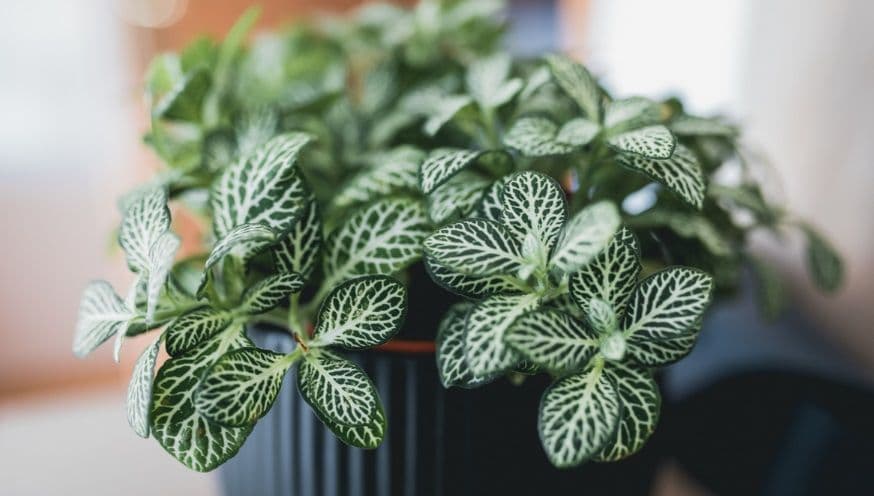
Gießen
Fittonias sind ziemlich wählerisch, wenn es um die Bewässerung geht. Sie mögen einen gleichmäßig feuchten Boden, reagieren aber empfindlich auf Überwässerung. Aber keine Sorge! Es ist nicht so schwierig, wie es scheint. Es kann einige Zeit dauern, bis du den richtigen Bewässerungsplan für deine Fittonia gefunden hast.
Am besten gießt du deine Fittonia, wenn sich die obersten 2-3 cm der Erde aschetrocken anfühlen. Steck einfach deinen Finger in die Erde oder verwende einen Feuchtigkeitsanzeiger, um die Bodenfeuchtigkeit zu messen. Wenn du dir nicht sicher bist, wann du deine Nervenpflanze gießen sollst, denk daran, dass es besser ist, wenn die Erde trocken ist als nass. Gieße deine Fittonia immer mit zimmerwarmem Wasser.
Experten-Tipp! Achte darauf, dass die Blätter nicht zu viel Wasser abbekommen, denn stehendes Wasser kann zu braunen oder gelben Flecken führen.
Fittonias sind Pflanzen, die etwas dramatisch sein können. Wenn sie auch nur ein bisschen durstig sind, lassen sie ihre Blätter hängen und lassen dich das dadurch wissen. Du brauchst dir jedoch keine Sorgen zu machen. Sie erholen sich schnell, wenn du sie gießt. Das sollte nur nicht zu oft vorkommen, denn sie reagieren empfindlich auf Unter- und Überwässerung. Kontrolliere immer den Boden, bevor du erneut gießt!
Dünger
Fittonias sind besonders langsam wachsende Zimmerpflanzen, daher ist es am besten, den Dünger etwas zu verdünnen, um eine Überdüngung zu vermeiden. Das Verdünnen des Düngers kann dazu beitragen, dass die Pflanze die benötigten Nährstoffe erhält, ohne übermäßig gedüngt zu werden. Die besten Ergebnisse erzielst du, wenn du PLNTSdünger alle 2 bis 4 Wochen verwendest und ihn auf die Hälfte der auf der Packung empfohlenen Stärke verdünnst.
Temperatur
Nervenpflanzen mögen warme Temperaturn wie tropische Pflanzen. Sie eignen sich gut für durchschnittliche Wohnungen, da sie zwischen 18°C und 24°C gedeihen. Wenn die Temperatur jedoch unter 16 °C sinkt, können die Blätter abfallen und die Pflanze wächst nicht mehr so gut. Experten-Tipp! Halte Fittonias bei einer konstanten Temperatur und stell sie nicht an einen zugigen Ort. Kühle Brisen können sie nachhaltig schädigen!
Ist es sicher, sie im Sommer ins Freie zu stellen (Europa)?
Wenn du in Europa lebst, kannst du deine Fittonia-Pflanzen im Sommer nach draußen stellen, aber nur, wenn es wärmer als 16 °C ist und du sie vor direkter Sonneneinstrahlung, kalten Brisen und starkem Wind schützt. Wenn du einen Balkon oder eine Terrasse hast, wäre das ein idealer Platz!
Wenn das Wetter im Sommer zu kalt ist, solltest du sie am besten im Haus lassen. Wenn du dich entscheidest, deine Fittonia nach draußen zu bringen, denk daran, sie wieder ins Haus zu holen, bevor die Nächte kühl werden!
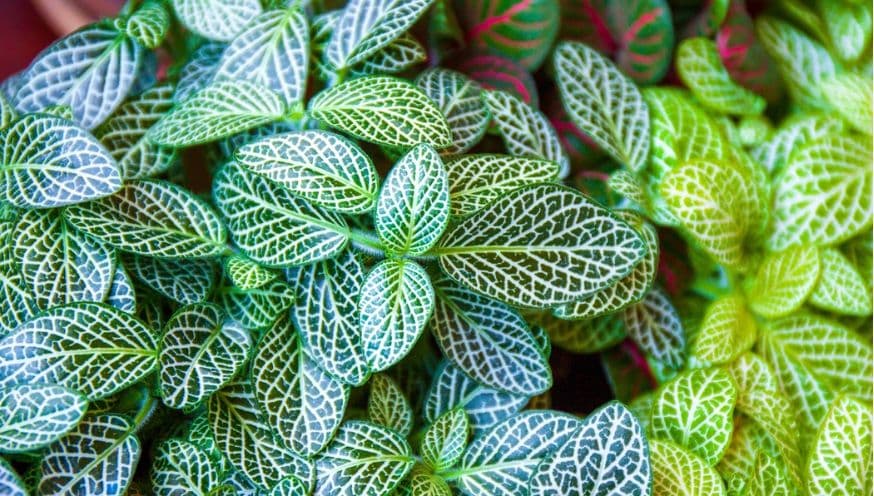
Luftfeuchtigkeit
Fittonia-Pflanzen, die ursprünglich aus den tropischen Regenwäldern stammen, gedeihen in einer feuchten Umgebung. Idealerweise mögen sie eine Luftfeuchtigkeit zwischen 50 und 70 %. Wenn die Luftfeuchtigkeit unter 40 % fällt, können die Blätter welken, sich kräuseln oder an den Rändern braun werden.
Experten-Tipp! Vermeide es, deine Fittonia abends oder nachts zu besprühen, denn stehendes Wasser auf den empfindlichen Blättern kann dunkle Flecken verursachen und einen Nährboden für Bakterien und Pilze schaffen. Wenn du sie morgens besprühst, kann überschüssiges Wasser schnell verdunsten.
Damit deine Fittonia auch in einem trockenen Raum gut gedeiht, stell ein Tablett mit Kieselsteinen in die Nähe der Pflanze oder verwende einen Raumbefeuchter. Da Fittonien oft als kleine Pflanzen verkauft werden, eignen sie sich hervorragend für Terrarien, in denen die Luftfeuchtigkeit genau richtig gehalten wird!
Umtopfen
Fittonia-Pflanzen müssen in der Regel alle 2-3 Jahre umgetopft werden, je nachdem, wie schnell sie wachsen und ob sie aus ihrem derzeitigen Topf herausgewachsen sind. Obwohl es sich nicht um schnell wachsende Pflanzen handelt, können sie schnell wachsen, wenn die Bedingungen geeignet sind.
Beim Umtopfen von Fittonia ist es am besten, einen Topf zu wählen, der etwas größer ist als der jetzige, da diese Pflanzen im Allgemeinen gerne Wurzeln schlagen. Mehr über das Umtopfen von Zimmerpflanzen erfährst du hier.
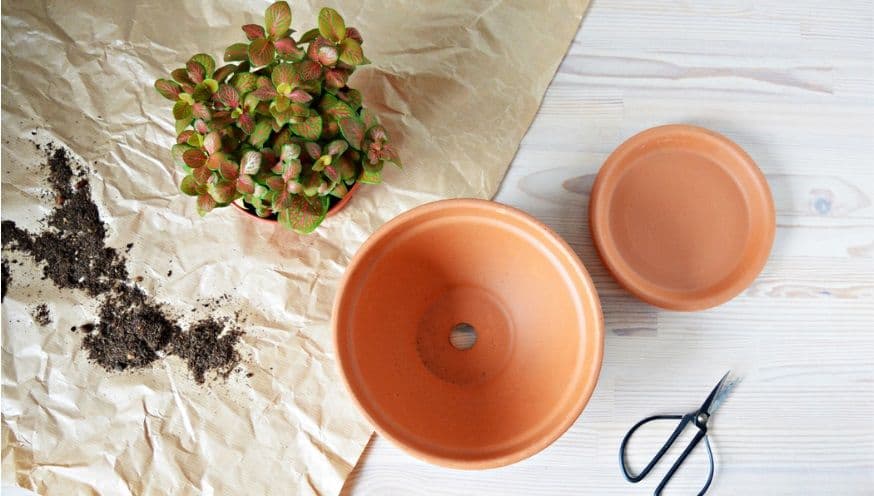
Erde & Substrat
Fittonia-Pflanzen gedeihen am besten in gut durchlässiger Erde mit einem pH-Wert von 6,0 bis 6,5. Verwende die organische Blumenerde von PLNTS, um gute Ergebnisse zu erzielen. Du kannst Vermiculit oder Perlit in die Erde geben, um die Belüftung, die Drainage und die Feuchtigkeitsspeicherung zu verbessern.
Fittonias Vermehren
Du kannst neue Fittonia-Pflanzen mit Hilfe von Stamm- oder Blattstecklingen oder durch Teilung der Pflanze vermehren. In der Regel dauert es 2 bis 4 Wochen, bis sie bewurzelt sind, aber manchmal kann es auch länger dauern, also keine Sorge, wenn es eine Weile dauert. Du kannst die Stecklinge mit Wurzelpulver bestäuben, um den Prozess zu beschleunigen.
Hier eine Schritt-für-Schritt-Anleitung für die Vermehrung von Fittonia durch Stammstecklinge:
- Wählen Sie einen gesunden Stamm mit mindestens 2 oder 4 Blättern. Schneide ihn vorsichtig mit einem scharfen Messer oder einer Schere ab. Entferne eventuell die unteren Blätter.
- Pflanze den Steckling in einen kleinen Topf mit PLNTS Stecklingserde und gieße ihn leicht an. Alternativ kannst du den Steckling auch in Wasser stellen und, wenn du Wurzeln siehst, in die Erde pflanzen.
- Decke den Topf mit Plastikfolie ab, um einen Treibhauseffekt zu erzielen, und stell ihn an einen hellen, warmen Ort. Achte darauf, den Steckling gut zu gießen und ihn nicht austrocknen zu lassen! Beobachte den Steckling regelmäßig und pflanze ihn nach ein paar Wochen um, sobald er Wurzeln geschlagen hat.
Hier ist eine schrittweise Anleitung für die Vermehrung von Fittonia durch Blattstecklinge:
- Schneide ein gesundes Blatt der Fittonia-Pflanze vorsichtig mit einem scharfen Messer oder einer Schere ab, und lass den Stängel etwa 1 cm lang stehen.
- Bereite einen kleinen Topf mit gut durchlässiger PLNTS Stecklingserde vor. Mach ein kleines Loch in die Erde und steck den Blattschnittstiel in das Loch. Sichere den Stiel, indem du ihn fest andrückst.
- Stell den Topf an einen warmen, hellen Ort und gieße den Steckling leicht, ohne ihn zu übergießen. Lass ihn aber auch nicht austrocknen! Nach einigen Wochen sollte der Blattschnitt anfangen zu wurzeln und neues Wachstum zu bilden.
Hier eine Schritt-für-Schritt-Anleitung für die Vermehrung von Fittonia durch Teilung:
- Nimm die Mutterpflanze aus dem Topf und trenne die Wurzeln und Stängel vorsichtig in kleinere Abschnitte. Achte darauf, dass jeder Abschnitt seine eigenen Wurzeln und Stängel mit Blättern hat.
- Bereite Töpfe mit gut durchlässiger Erde vor und pflanze jedes Teilstück in seinen eigenen Topf.
- Stelle die Töpfe an einen hellen, warmen Ort und pflege die neuen Pflanzen weiter, während sie zu erwachsenen Fittonia-Pflanzen heranwachsen.
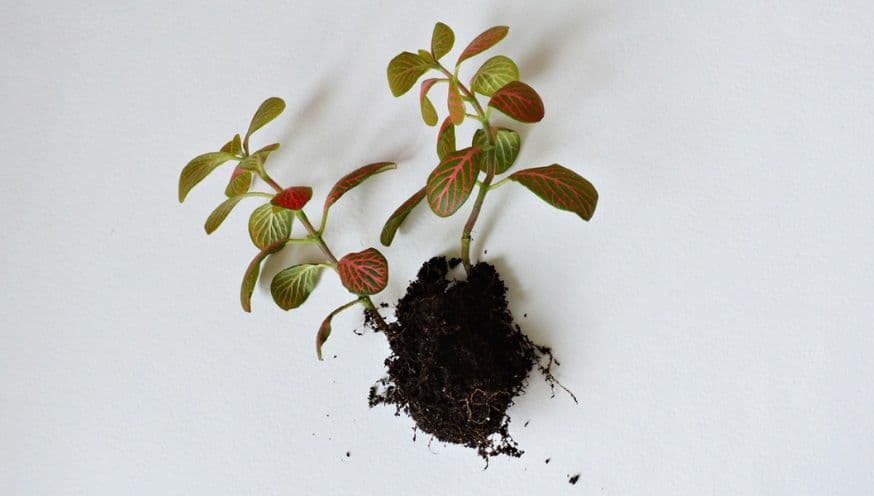
Häufige Krankheiten und Schädlinge an Fittonia
Wenn die Fittonia im Haus gehalten wird, leidet sie kaum unter Schädlingen und Krankheiten. Thripse, Wollläuse und Spinnmilben sind die häufigsten Schädlinge, die Fittonia befallen. Schädlinge können deine Fittonia schwächen und verschiedene Krankheiten verursachen, darunter auch solche, die von Thripsen übertragen werden. Fittonia kann von Wurzelfäule, Mehltau und Blattfleckenkrankheiten befallen werden.
Behalte also deine Fittonia im Auge, und wenn du den Eindruck hast, dass etwas nicht stimmt, schau auf unserer PLNTSdoctor-Seite nach, was los ist und wie man es am besten bekämpfen kann.
Fittonia Vielfalt
Es gibt mehrere Sorten von Fittonia-Pflanzen, jede mit deinem eigenen einzigartigen Aussehen. Die Fittonia Verschaffeltii hat grüne Blätter mit verschlungenen weißen Adern, während die Sorte Joly Josan dunkelgrüne Blätter mit zartrosa Adern hat. Die Sorte Red Forest Flames hat tiefrote Adern, die sich von den grünen Blättern abheben, und die Sorte Pink Forest Flames hat leuchtend rosa Adern auf den grünen Blättern. Es gibt so viele schöne Sorten, dass für jeden Geschmack etwas dabei ist!
Sind Fittonias giftig?
Mehrere Quellen geben an, dass Fittonias für Haustiere ungefährlich sind. Juhu! Sie sind nicht nur für Haustiere, sondern auch für Menschen und damit auch für Kinder unbedenklich, es gibt also nichts zu befürchten. Wie toll ist das denn?
Fittonia online kaufen bei PLNTS.com
Bei PLNTS.com kannst du deine neue Fittonia online kaufen, zum Beispiel die Fittonia Verschaffeltii und die Fittonia Pink Forest Flame. Ob du deine Fittonias von Anfang an groß magst oder ob du sie von winzigen BabyPLNTS zu ausgewachsenen PLNTS heranziehen möchtest – kauf deine neue Fittonia online bei PLNTS.com.

